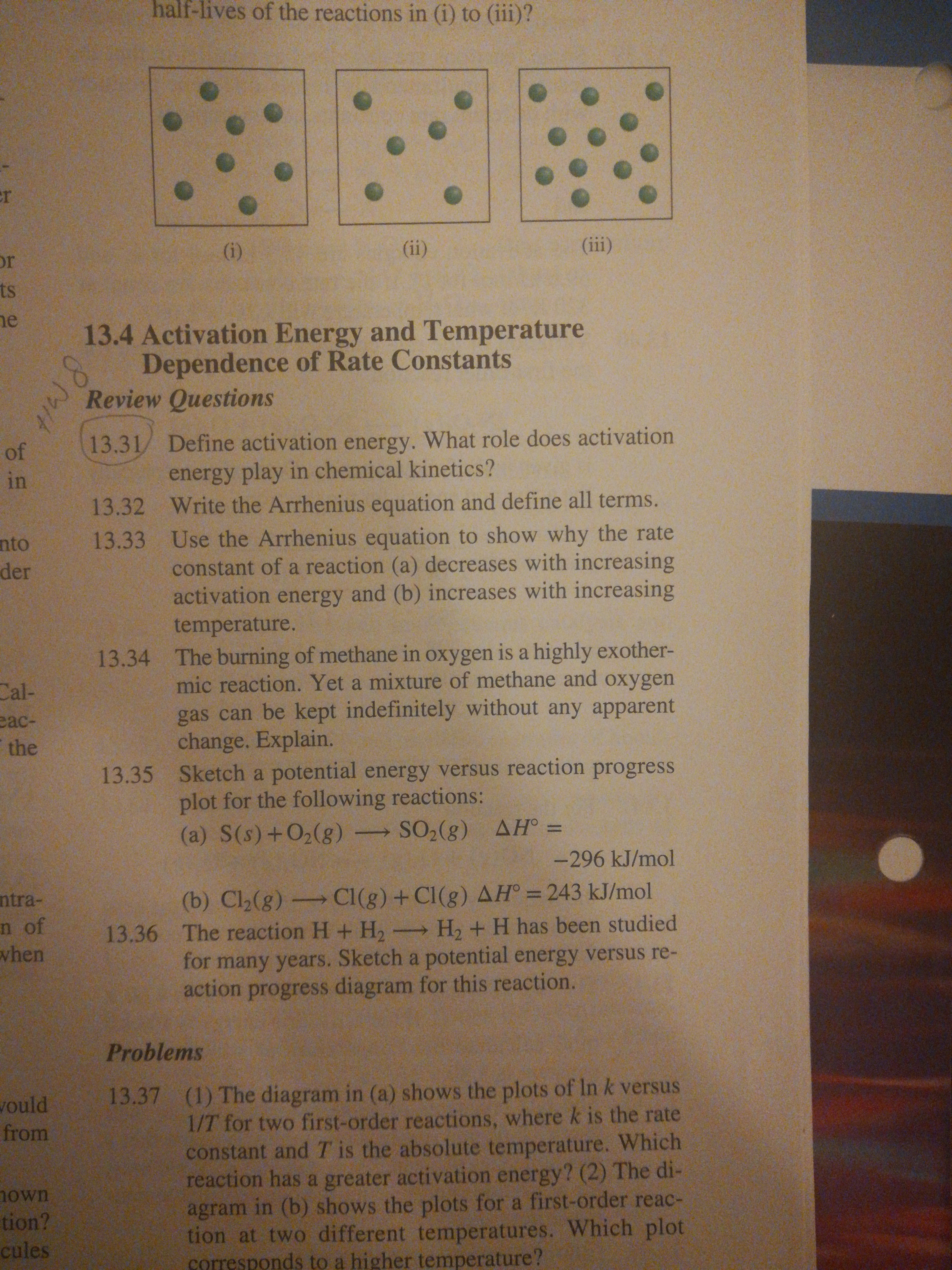half-lives of the reactions in (i) to (iii)? er (i) (ii) (iii) or ts he 13.4 Activation Energy and Temperature Dependence of Rate Constants Review Questions 13.31/ Define activation energy. What role does activation energy play in chemical kinetics? Write the Arrhenius equation and define all terms. of in 13.32 nto der 13.33 Use the Arrhenius equation to show why the rate constant of a reaction (a) decreases with increasing activation energy and (b) increases with increasing temperature. 13.34 The burning of methane in oxygen is a highly exother- Cal- eac- mic reaction. Yet a mixture of methane and oxygen gas can be kept indefinitely without any apparent change. Explain. the 13.35 Sketch a potential energy versus reaction progress plot for the following reactions: (a) S(s)+O2(g) SO2(g) AH° = %3D -> -296 kJ/mol %3D ntra- (b) Cl2(g) Cl(g) +Cl(g) AH =243 kJ/mol -> n of when 13.36 The reaction H + H, H, + H has been studied for many years. Sketch a potential energy versus re- action progress diagram for this reaction. Problems 13.37 (1) The diagram in (a) shows the plots of In k versus would from 1/T for two first-order reactions, where k is the rate constant and T is the absolute temperature. Which reaction has a greater activation energy? (2) The di- agram in (b) shows the plots for a first-order reac- tion at two different temperatures. Which plot corresponds to a higher temperature? nown tion? cules
half-lives of the reactions in (i) to (iii)? er (i) (ii) (iii) or ts he 13.4 Activation Energy and Temperature Dependence of Rate Constants Review Questions 13.31/ Define activation energy. What role does activation energy play in chemical kinetics? Write the Arrhenius equation and define all terms. of in 13.32 nto der 13.33 Use the Arrhenius equation to show why the rate constant of a reaction (a) decreases with increasing activation energy and (b) increases with increasing temperature. 13.34 The burning of methane in oxygen is a highly exother- Cal- eac- mic reaction. Yet a mixture of methane and oxygen gas can be kept indefinitely without any apparent change. Explain. the 13.35 Sketch a potential energy versus reaction progress plot for the following reactions: (a) S(s)+O2(g) SO2(g) AH° = %3D -> -296 kJ/mol %3D ntra- (b) Cl2(g) Cl(g) +Cl(g) AH =243 kJ/mol -> n of when 13.36 The reaction H + H, H, + H has been studied for many years. Sketch a potential energy versus re- action progress diagram for this reaction. Problems 13.37 (1) The diagram in (a) shows the plots of In k versus would from 1/T for two first-order reactions, where k is the rate constant and T is the absolute temperature. Which reaction has a greater activation energy? (2) The di- agram in (b) shows the plots for a first-order reac- tion at two different temperatures. Which plot corresponds to a higher temperature? nown tion? cules
Chemistry
10th Edition
ISBN:9781305957404
Author:Steven S. Zumdahl, Susan A. Zumdahl, Donald J. DeCoste
Publisher:Steven S. Zumdahl, Susan A. Zumdahl, Donald J. DeCoste
Chapter12: Chemical Kinetics
Section: Chapter Questions
Problem 82E: The decomposition of NH3 to N2 and H2 was studied on two surfaces: Surface Ea (kJ/mol) W 163 Os 197...
Related questions
Question
13.31

Transcribed Image Text:half-lives of the reactions in (i) to (iii)?
er
(i)
(ii)
(iii)
or
ts
he
13.4 Activation Energy and Temperature
Dependence of Rate Constants
Review Questions
13.31/ Define activation energy. What role does activation
energy play in chemical kinetics?
Write the Arrhenius equation and define all terms.
of
in
13.32
nto
der
13.33 Use the Arrhenius equation to show why the rate
constant of a reaction (a) decreases with increasing
activation energy and (b) increases with increasing
temperature.
13.34 The burning of methane in oxygen is a highly exother-
Cal-
eac-
mic reaction. Yet a mixture of methane and oxygen
gas can be kept indefinitely without any apparent
change. Explain.
the
13.35 Sketch a potential energy versus reaction progress
plot for the following reactions:
(a) S(s)+O2(g) SO2(g) AH° =
%3D
->
-296 kJ/mol
%3D
ntra-
(b) Cl2(g) Cl(g) +Cl(g) AH =243 kJ/mol
->
n of
when
13.36 The reaction H + H, H, + H has been studied
for many years. Sketch a potential energy versus re-
action progress diagram for this reaction.
Problems
13.37 (1) The diagram in (a) shows the plots of In k versus
would
from
1/T for two first-order reactions, where k is the rate
constant and T is the absolute temperature. Which
reaction has a greater activation energy? (2) The di-
agram in (b) shows the plots for a first-order reac-
tion at two different temperatures. Which plot
corresponds to a higher temperature?
nown
tion?
cules
Expert Solution
This question has been solved!
Explore an expertly crafted, step-by-step solution for a thorough understanding of key concepts.
This is a popular solution!
Trending now
This is a popular solution!
Step by step
Solved in 2 steps with 1 images

Knowledge Booster
Learn more about
Need a deep-dive on the concept behind this application? Look no further. Learn more about this topic, chemistry and related others by exploring similar questions and additional content below.Recommended textbooks for you

Chemistry
Chemistry
ISBN:
9781305957404
Author:
Steven S. Zumdahl, Susan A. Zumdahl, Donald J. DeCoste
Publisher:
Cengage Learning


Chemistry: An Atoms First Approach
Chemistry
ISBN:
9781305079243
Author:
Steven S. Zumdahl, Susan A. Zumdahl
Publisher:
Cengage Learning

Chemistry
Chemistry
ISBN:
9781305957404
Author:
Steven S. Zumdahl, Susan A. Zumdahl, Donald J. DeCoste
Publisher:
Cengage Learning


Chemistry: An Atoms First Approach
Chemistry
ISBN:
9781305079243
Author:
Steven S. Zumdahl, Susan A. Zumdahl
Publisher:
Cengage Learning

Chemistry for Engineering Students
Chemistry
ISBN:
9781337398909
Author:
Lawrence S. Brown, Tom Holme
Publisher:
Cengage Learning

Chemistry: Principles and Reactions
Chemistry
ISBN:
9781305079373
Author:
William L. Masterton, Cecile N. Hurley
Publisher:
Cengage Learning

Principles of Modern Chemistry
Chemistry
ISBN:
9781305079113
Author:
David W. Oxtoby, H. Pat Gillis, Laurie J. Butler
Publisher:
Cengage Learning